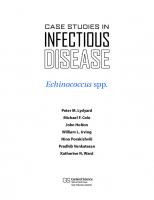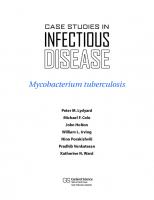Case Studies in Infectious Disease: Schistosoma Spp 9781136985782, 9780815341420, 0203854047, 0815341423, 1136985786
Case Studies in Infectious Disease: Schistosoma spp. presents the natural history of this infection from point of entry
291 35 1MB
English Pages 608 [19] Year 2009
Book Cover......Page 1
Title......Page 2
Copyright......Page 3
Preface to Case Studies in Infectious Disease......Page 4
Table of Contents......Page 5
Schistosoma spp.......Page 8
Answers to Multiple Choice Questions......Page 18
Recommend Papers

- Author / Uploaded
- Lydyard
- Peter;Cole
- Michael;Holton
- John;Irving
- William L
File loading please wait...
Citation preview
Schistosoma spp.
Peter M. Lydyard Michael F. Cole John Holton William L. Irving Nino Porakishvili Pradhib Venkatesan Katherine N. Ward
This edition published in the Taylor & Francis e-Library, 2009. To purchase your own copy of this or any of Taylor & Francis or Routledge’s collection of thousands of eBooks please go to www.eBookstore.tandf.co.uk.
Vice President: Denise Schanck Editor: Elizabeth Owen Editorial Assistant: Sarah E. Holland Senior Production Editor: Simon Hill Typesetting: Georgina Lucas Cover Design: Andy Magee Proofreader: Sally Huish Indexer: Merrall-Ross International Ltd
©2010 by Garland Science, Taylor & Francis Group, LLC
This book contains information obtained from authentic and highly regarded sources. Reprinted material is quoted with permission, and sources are indicated. A wide variety of references are listed. Reasonable efforts have been made to publish reliable data and information, but the author and the publisher cannot assume responsibility for the validity of all materials or for the consequences of their use. All rights reserved. No part of this book covered by the copyright heron may be reproduced or used in any format in any form or by any means—graphic, electronic, or mechanical, including photocopying, recording, taping, or information storage and retrieval systems—without permission of the publisher.
The publisher makes no representation, express or implied, that the drug doses in this book are correct. Readers must check up to date product information and clinical procedures with the manufacturers, current codes of conduct, and current safety regulations. ISBN 978-0-8153-4142-0 Library of Congress Cataloging-in-Publication Data Case studies in infectious disease / Peter M Lydyard ... [et al.]. p. ; cm. Includes bibliographical references. SBN 978-0-8153-4142-0 1. Communicable diseases--Case studies. I. Lydyard, Peter M. [DNLM: 1. Communicable Diseases--Case Reports. 2. Bacterial Infections--Case Reports. 3. Mycoses--Case Reports. 4. Parasitic Diseases-Case Reports. 5. Virus Diseases--Case Reports. WC 100 C337 2009] RC112.C37 2009 616.9--dc22 2009004968
Published by Garland Science, Taylor & Francis Group, LLC, an informa business 270 Madison Avenue, New York NY 10016, USA, and 2 Park Square, Milton Park, Abingdon, OX14 4RN, UK. Visit our web site at http://www.garlandscience.com ISBN 0-203-85404-7 Master e-book ISBN
Peter M. Lydyard, Emeritus Professor of Immunology, University College Medical School, London, UK and Honorary Professor of Immunology, School of Biosciences, University of Westminster, London, UK. Michael F. Cole, Professor of Microbiology & Immunology, Georgetown University School of Medicine, Washington, DC, USA. John Holton, Reader and Honorary Consultant in Clinical Microbiology, Windeyer Institute of Medical Sciences, University College London and University College London Hospital Foundation Trust, London, UK. William L. Irving, Professor and Honorary Consultant in Virology, University of Nottingham and Nottingham University Hospitals NHS Trust, Nottingham, UK. Nino Porakishvili, Senior Lecturer, School of Biosciences, University of Westminster, London, UK and Honorary Professor, Javakhishvili Tbilisi State University, Tbilisi, Georgia. Pradhib Venkatesan, Consultant in Infectious Diseases, Nottingham University Hospitals NHS Trust, Nottingham, UK. Katherine N. Ward, Consultant Virologist and Honorary Senior Lecturer, University College Medical School, London, UK and Honorary Consultant, Health Protection Agency, UK.
Preface to Case Studies in Infectious Disease The idea for this book came from a successful course in a medical school setting. Each of the forty cases has been selected by the authors as being those that cause the most morbidity and mortality worldwide. The cases themselves follow the natural history of infection from point of entry of the pathogen through pathogenesis, clinical presentation, diagnosis, and treatment. We believe that this approach provides the reader with a logical basis for understanding these diverse medically-important organisms. Following the description of a case history, the same five sets of core questions are asked to encourage the student to think about infections in a common sequence. The initial set concerns the nature of the infectious agent, how it gains access to the body, what cells are infected, and how the organism spreads; the second set asks about host defense mechanisms against the agent and how disease is caused; the third set enquires about the clinical manifestations of the infection and the complications that can occur; the fourth set is related to how the infection is diagnosed, and what is the differential diagnosis, and the final set asks how the infection is managed, and what preventative measures can be taken to avoid the infection. In order to facilitate the learning process, each case includes summary bullet points, a reference list, a further reading list and some relevant reliable websites. Some of the websites contain images that are referred to in the text. Each chapter concludes with multiple-choice questions for self-testing with the answers given in the back of the book. In the contents section, diseases are listed alphabetically under the causative agent. A separate table categorizes the pathogens as bacterial, viral, protozoal/worm/fungal and acts as a guide to the relative involvement of each body system affected. Finally, there is a comprehensive glossary to allow rapid access to microbiology and medical terms highlighted in bold in the text. All figures are available in JPEG and PowerPoint® format at www.garlandscience.com/gs_textbooks.asp We believe that this book would be an excellent textbook for any course in microbiology and in particular for medical students who need instant access to key information about specific infections. Happy learning!!
The authors March, 2009
Table of Contents The glossary for Case Studies in Infectious Disease can be found at http://www.garlandscience.com/textbooks/0815341423.asp Case 1 Case 2 Case 3 Case 4 Case 5 Case 6 Case 7 Case 8 Case 9 Case 10 Case 11 Case 12 Case 13 Case 14 Case 15 Case 16 Case 17 Case 18 Case 19 Case 20 Case 21 Case 22 Case 23 Case 24 Case 25 Case 26 Case 27 Case 28 Case 29 Case 30 Case 31 Case 32 Case 33 Case 34 Case 35 Case 36 Case 37 Case 38 Case 39 Case 40
Aspergillus fumigatus Borellia burgdorferi and related species Campylobacter jejuni Chlamydia trachomatis Clostridium difficile Coxiella burnetti Coxsackie B virus Echinococcus spp. Epstein-Barr virus Escherichia coli Giardia lamblia Helicobacter pylori Hepatitis B virus Herpes simplex virus 1 Herpes simplex virus 2 Histoplasma capsulatum Human immunodeficiency virus Influenza virus Leishmania spp. Leptospira spp. Listeria monocytogenes Mycobacterium leprae Mycobacterium tuberculosis Neisseria gonorrhoeae Neisseria meningitidis Norovirus Parvovirus Plasmodium spp. Respiratory syncytial virus Rickettsia spp. Salmonella typhi Schistosoma spp. Staphylococcus aureus Streptococcus mitis Streptococcus pneumoniae Streptococcus pyogenes Toxoplasma gondii Trypanosoma spp. Varicella-zoster virus Wuchereia bancrofti
Guide to the relative involvement of each body system affected by the infectious organisms described in this book: the organisms are categorized into bacteria, viruses, and protozoa/fungi/worms
Organism
Resp
MS
GI
H/B
GU
CNS
CV
Skin
Syst
1+
1+
L/H
Bacteria Borrelia burgdorferi
4+
Campylobacter jejuni
4+
Chlamydia trachomatis
2+ 2+
Clostridium difficile
4+
4+
Coxiella burnetti
4+
Escherichia coli
4+
4+
Helicobacter pylori
4+
4+
4+
4+
4+
Listeria monocytogenes
2+
4+
Mycobacterium leprae
4+ 4+
4+
2+ 4+
Neisseria meningitidis
2+ 4+
Rickettsia spp.
4+ 4+
Salmonella typhi
4+
4+ 1+
1+
2+
1+ 1+
4+
Streptococcus pyogenes
4+ 4+
Streptococcus mitis Streptococcus pneumoniae
2+
2+
Neisseria gonorrhoeae
Staphylococcus aureus
4+
4+
Leptospira spp.
Mycobacterium tuberculosis
2+
4+
1+
4+
3+
4+
4+ 3+
Viruses Coxsackie B virus
1+
1+
4+
1+
Epstein-Barr virus Hepatitis B virus
4+
2+
4+
4+
Herpes simplex virus 1
2+
4+
4+
Herpes simplex virus 2
4+
2+
4+
2+
Human immunodeficiency virus
Influenza virus
2+
4+
1+
Norovirus
1+
4+
Parvovirus
2+
Respiratory syncytial virus
4+
Varicella-zoster virus
2+
3+
4+ 2+
4+
2+
Protozoa/Fungi/Worms Aspergillus fumigatus
4+
Echinococcus spp.
2+
Giardia lamblia Histoplasma capsulatum
1+ 4+ 4+
3+
1+
Leishmania spp.
4+
4+ 4+
4+
4+ 4+
Toxoplasma gondii Trypanosoma spp.
4+ 4+
Plasmodium spp. Schistosoma spp.
2+
2+ 4+
Wuchereria bancrofti
4+
4+ 4+ 4+
The rating system (+4 the strongest, +1 the weakest) indicates the greater to lesser involvement of the body system. KEY: Resp = Respiratory: MS = Musculoskeletal: GI = Gastrointestinal H/B = Hepatobiliary: GU = Genitourinary: CNS = Central Nervous System Skin = Dermatological: Syst = Systemic: L/H = Lymphatic-Hematological
Schistosoma spp.
A 25-year-old male was admitted to hospital vomiting blood. On examination of the abdomen both the liver and the spleen were enlarged. A full blood count revealed a reduced hemoglobin level of 9 g dl–1 and the white cell differential showed a raised eosinophil count of 1.1 ¥ 109 L–1 (normal range


![Case Studies In Infectious Disease [1st ed.]
0815341423, 9780815341420](https://ebin.pub/img/200x200/case-studies-in-infectious-disease-1stnbsped-0815341423-9780815341420.jpg)






